Taehyun Kim
Multi-channel convolutional neural quantum embedding
Sep 26, 2025Abstract:Classification using variational quantum circuits is a promising frontier in quantum machine learning. Quantum supervised learning (QSL) applied to classical data using variational quantum circuits involves embedding the data into a quantum Hilbert space and optimizing the circuit parameters to train the measurement process. In this context, the efficacy of QSL is inherently influenced by the selection of quantum embedding. In this study, we introduce a classical-quantum hybrid approach for optimizing quantum embedding beyond the limitations of the standard circuit model of quantum computation (i.e., completely positive and trace-preserving maps) for general multi-channel data. We benchmark the performance of various models in our framework using the CIFAR-10 and Tiny ImageNet datasets and provide theoretical analyses that guide model design and optimization.
Expanding Foundational Language Capabilities in Open-Source LLMs through a Korean Case Study
Sep 04, 2025Abstract:We introduce Llama-3-Motif, a language model consisting of 102 billion parameters, specifically designed to enhance Korean capabilities while retaining strong performance in English. Developed on the Llama 3 architecture, Llama-3-Motif employs advanced training techniques, including LlamaPro and Masked Structure Growth, to effectively scale the model without altering its core Transformer architecture. Using the MoAI platform for efficient training across hyperscale GPU clusters, we optimized Llama-3-Motif using a carefully curated dataset that maintains a balanced ratio of Korean and English data. Llama-3-Motif shows decent performance on Korean-specific benchmarks, outperforming existing models and achieving results comparable to GPT-4.
MoNDE: Mixture of Near-Data Experts for Large-Scale Sparse Models
May 29, 2024Abstract:Mixture-of-Experts (MoE) large language models (LLM) have memory requirements that often exceed the GPU memory capacity, requiring costly parameter movement from secondary memories to the GPU for expert computation. In this work, we present Mixture of Near-Data Experts (MoNDE), a near-data computing solution that efficiently enables MoE LLM inference. MoNDE reduces the volume of MoE parameter movement by transferring only the $\textit{hot}$ experts to the GPU, while computing the remaining $\textit{cold}$ experts inside the host memory device. By replacing the transfers of massive expert parameters with the ones of small activations, MoNDE enables far more communication-efficient MoE inference, thereby resulting in substantial speedups over the existing parameter offloading frameworks for both encoder and decoder operations.
Embracing Limited and Imperfect Data: A Review on Plant Stress Recognition Using Deep Learning
May 19, 2023Abstract:Plant stress recognition has witnessed significant improvements in recent years with the advent of deep learning. A large-scale and annotated training dataset is required to achieve decent performance; however, collecting it is frequently difficult and expensive. Therefore, deploying current deep learning-based methods in real-world applications may suffer primarily from limited and imperfect data. Embracing them is a promising strategy that has not received sufficient attention. From this perspective, a systematic survey was conducted in this study, with the ultimate objective of monitoring plant growth by implementing deep learning, which frees humans and potentially reduces the resultant losses from plant stress. We believe that our paper has highlighted the importance of embracing this limited and imperfect data and enhanced its relevant understanding.
ComMU: Dataset for Combinatorial Music Generation
Nov 17, 2022



Abstract:Commercial adoption of automatic music composition requires the capability of generating diverse and high-quality music suitable for the desired context (e.g., music for romantic movies, action games, restaurants, etc.). In this paper, we introduce combinatorial music generation, a new task to create varying background music based on given conditions. Combinatorial music generation creates short samples of music with rich musical metadata, and combines them to produce a complete music. In addition, we introduce ComMU, the first symbolic music dataset consisting of short music samples and their corresponding 12 musical metadata for combinatorial music generation. Notable properties of ComMU are that (1) dataset is manually constructed by professional composers with an objective guideline that induces regularity, and (2) it has 12 musical metadata that embraces composers' intentions. Our results show that we can generate diverse high-quality music only with metadata, and that our unique metadata such as track-role and extended chord quality improves the capacity of the automatic composition. We highly recommend watching our video before reading the paper (https://pozalabs.github.io/ComMU).
UBoCo : Unsupervised Boundary Contrastive Learning for Generic Event Boundary Detection
Nov 30, 2021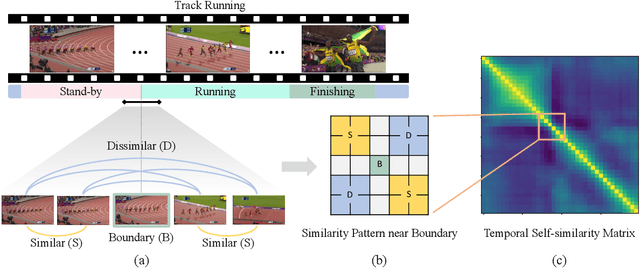
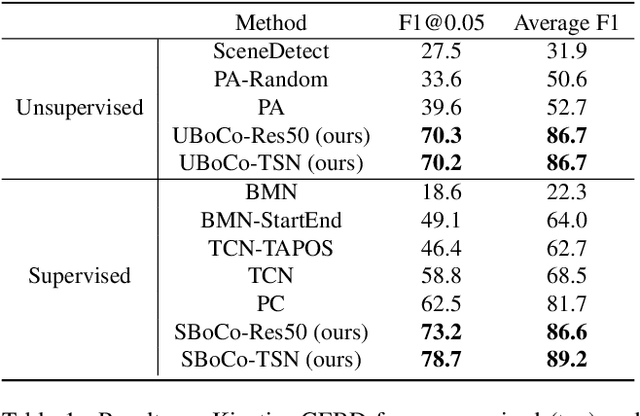
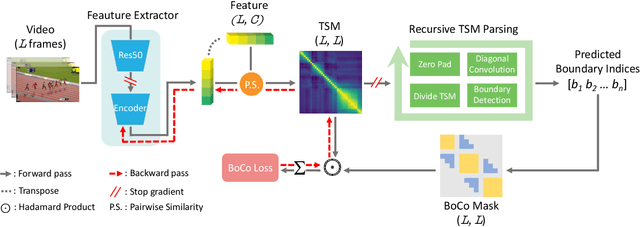

Abstract:Generic Event Boundary Detection (GEBD) is a newly suggested video understanding task that aims to find one level deeper semantic boundaries of events. Bridging the gap between natural human perception and video understanding, it has various potential applications, including interpretable and semantically valid video parsing. Still at an early development stage, existing GEBD solvers are simple extensions of relevant video understanding tasks, disregarding GEBD's distinctive characteristics. In this paper, we propose a novel framework for unsupervised/supervised GEBD, by using the Temporal Self-similarity Matrix (TSM) as the video representation. The new Recursive TSM Parsing (RTP) algorithm exploits local diagonal patterns in TSM to detect boundaries, and it is combined with the Boundary Contrastive (BoCo) loss to train our encoder to generate more informative TSMs. Our framework can be applied to both unsupervised and supervised settings, with both achieving state-of-the-art performance by a huge margin in GEBD benchmark. Especially, our unsupervised method outperforms the previous state-of-the-art "supervised" model, implying its exceptional efficacy.
Winning the CVPR'2021 Kinetics-GEBD Challenge: Contrastive Learning Approach
Jun 22, 2021
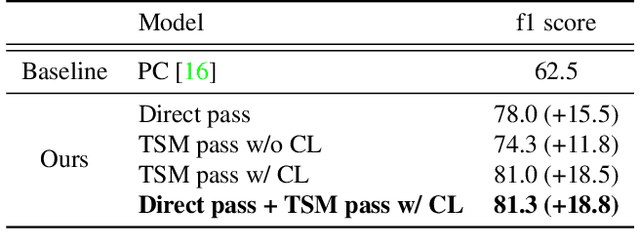

Abstract:Generic Event Boundary Detection (GEBD) is a newly introduced task that aims to detect "general" event boundaries that correspond to natural human perception. In this paper, we introduce a novel contrastive learning based approach to deal with the GEBD. Our intuition is that the feature similarity of the video snippet would significantly vary near the event boundaries, while remaining relatively the same in the remaining part of the video. In our model, Temporal Self-similarity Matrix (TSM) is utilized as an intermediate representation which takes on a role as an information bottleneck. With our model, we achieved significant performance boost compared to the given baselines. Our code is available at https://github.com/hello-jinwoo/LOVEU-CVPR2021.
GradPIM: A Practical Processing-in-DRAM Architecture for Gradient Descent
Feb 15, 2021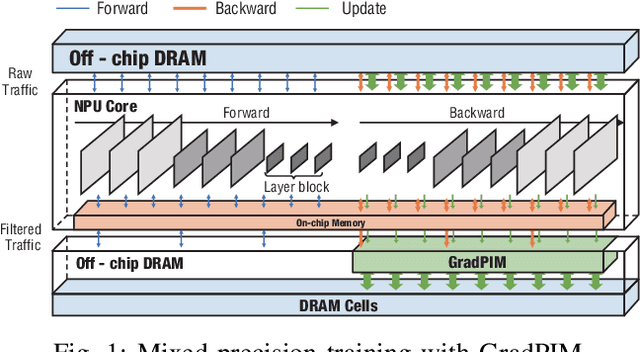
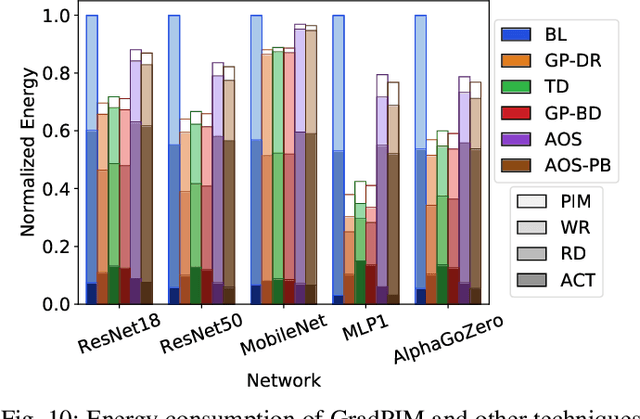
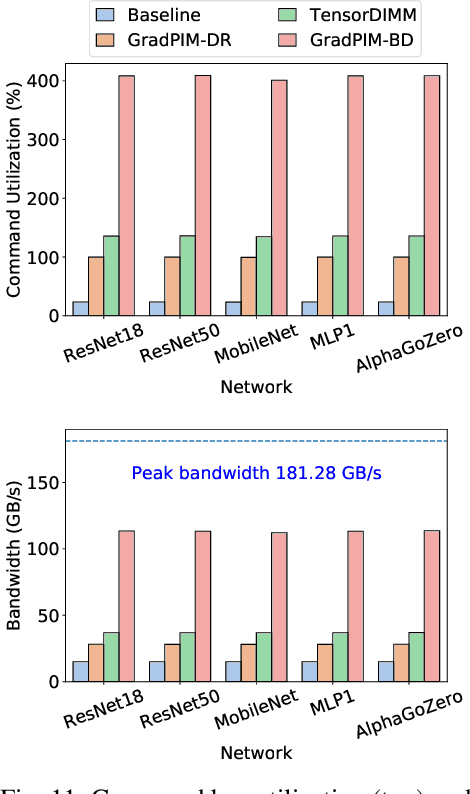
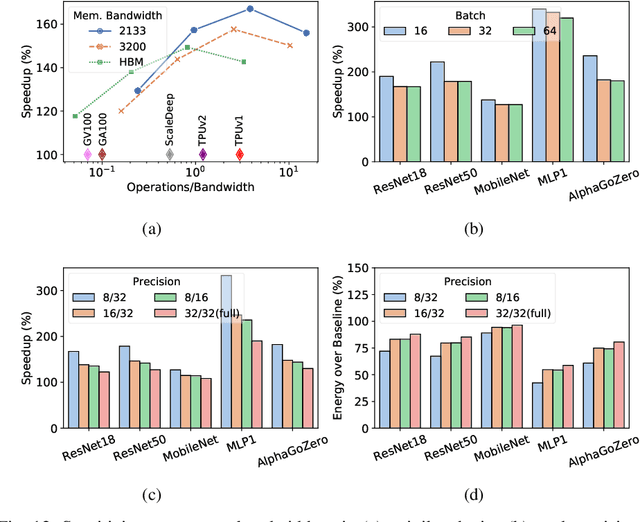
Abstract:In this paper, we present GradPIM, a processing-in-memory architecture which accelerates parameter updates of deep neural networks training. As one of processing-in-memory techniques that could be realized in the near future, we propose an incremental, simple architectural design that does not invade the existing memory protocol. Extending DDR4 SDRAM to utilize bank-group parallelism makes our operation designs in processing-in-memory (PIM) module efficient in terms of hardware cost and performance. Our experimental results show that the proposed architecture can improve the performance of DNN training and greatly reduce memory bandwidth requirement while posing only a minimal amount of overhead to the protocol and DRAM area.
Posting Bot Detection on Blockchain-based Social Media Platform using Machine Learning Techniques
Aug 28, 2020



Abstract:Steemit is a blockchain-based social media platform, where authors can get author rewards in the form of cryptocurrencies called STEEM and SBD (Steem Blockchain Dollars) if their posts are upvoted. Interestingly, curators (or voters) can also get rewards by voting others' posts, which is called a curation reward. A reward is proportional to a curator's STEEM stakes. Throughout this process, Steemit hopes "good" content will be automatically discovered by users in a decentralized way, which is known as the Proof-of-Brain (PoB). However, there are many bot accounts programmed to post automatically and get rewards, which discourages real human users from creating good content. We call this type of bot a posting bot. While there are many papers that studied bots on traditional centralized social media platforms such as Facebook and Twitter, we are the first to study posting bots on a blockchain-based social media platform. Compared with the bot detection on the usual social media platforms, the features we created have an advantage that posting bots can be detected without limiting the number or length of posts. We can extract the features of posts by clustering distances between blog data or replies. These features are obtained from the Minimum Average Cluster from Clustering Distance between Frequent words and Articles (MAC-CDFA), which is not used in any of the previous social media research. Based on the enriched features, we enhanced the quality of classification tasks. Comparing the F1-scores, the features we created outperformed the features used for bot detection on Facebook and Twitter.
 Add to Chrome
Add to Chrome Add to Firefox
Add to Firefox Add to Edge
Add to Edge